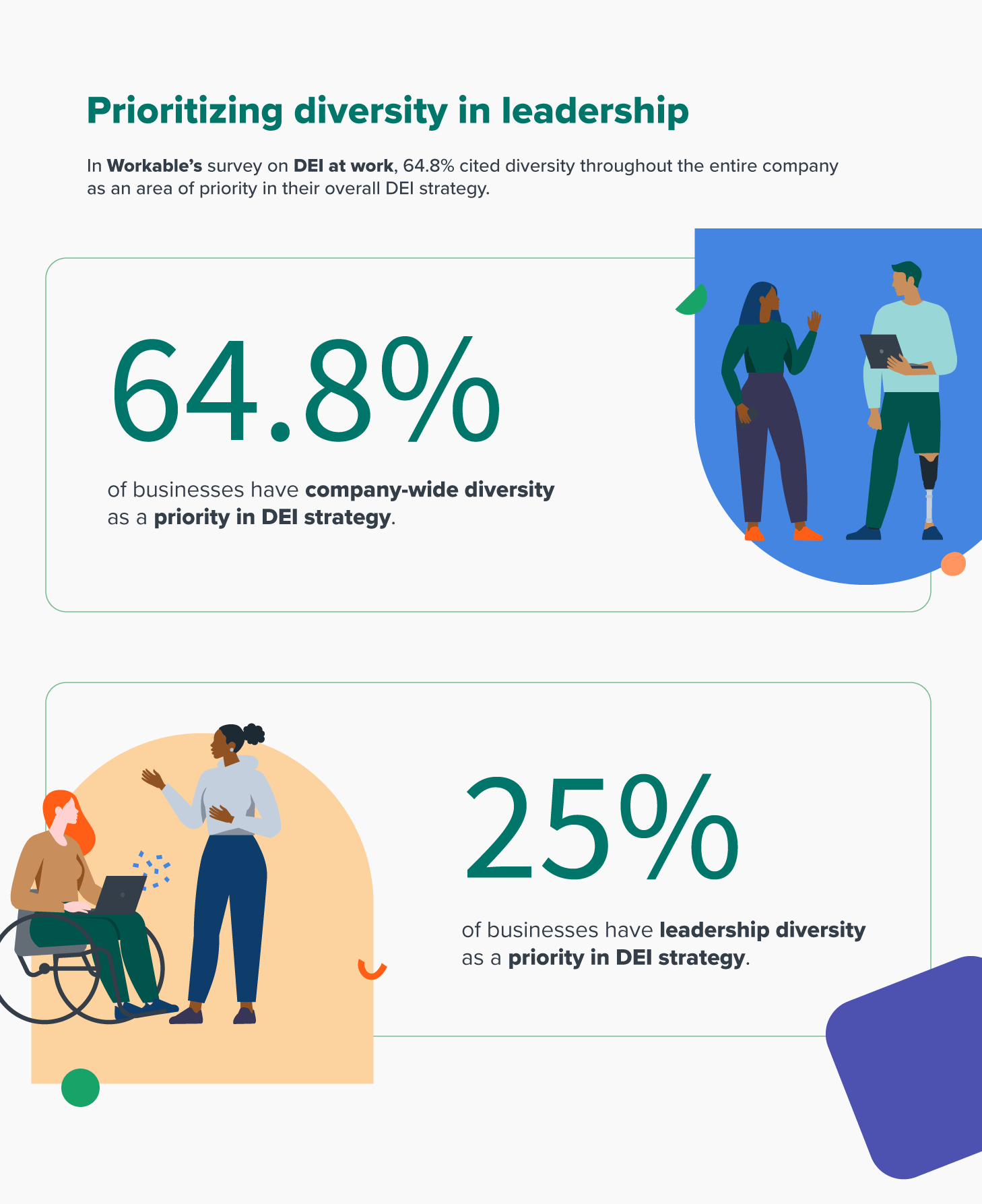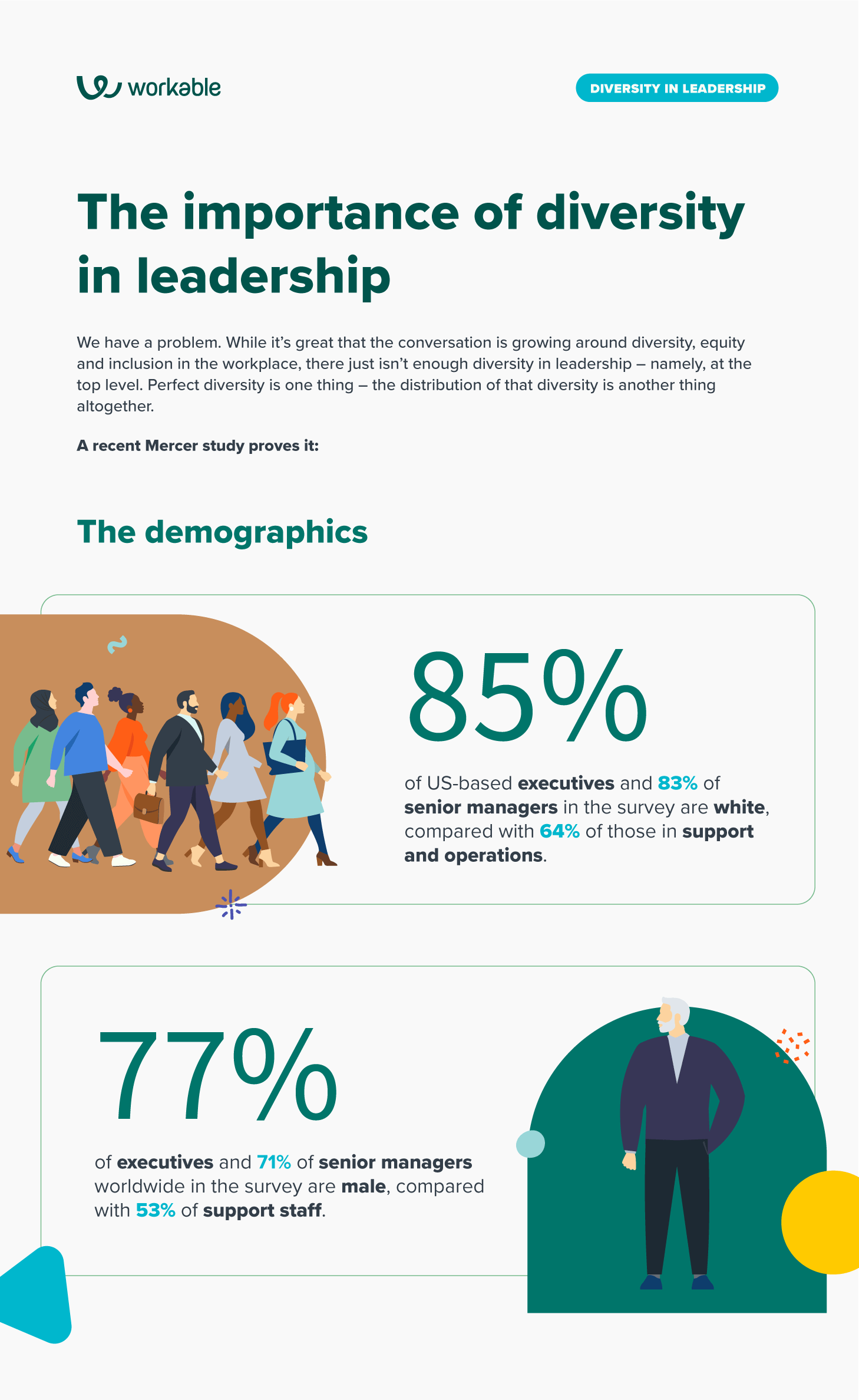Diversity in leadership: Why it matters and what you can do
Diversity in leadership is crucial as it brings a greater depth of experience and perspective, fostering innovation and better understanding of employees and clients. It positively impacts the bottom line, with companies showing more diversity at the executive level being more likely to generate higher profits.

We have a problem. While it’s great that the conversation is growing around diversity, equity and inclusion in the workplace, there just isn’t enough diversity in <em>leadership</em> – namely, at the top level. Perfect diversity is one thing – the distribution of that diversity is another thing altogether.
A recent Mercer study proves this lack of diversity in leadership:
Contents
The demographics of leadership
- 85% of US-based executives and 83% of senior managers in the survey are white, compared with 64% of those in support and operations.
- 77% of executives and 71% of senior managers worldwide in the survey are male, compared with 53% of support staff.
Seeing these numbers, you’d expect some momentum to increase that diversity at the executive level. There is – but not to the scale you might think.
Contents:
- The demographics of leadership
- Prioritizing diversity in leadership
- Why is diversity in leadership important?
- Diversity in leadership: The payoff
- Diversity in leadership: The initiative
- Diversity in leadership: The action items
- Diversity in leadership: Leaders demand it
Want to see the full infographic? Download it for yourself here. Or read on:
Prioritizing diversity in leadership
In Workable’s survey on DEI at work, 64.8% cited diversity throughout the entire company as an area of priority in their overall DEI strategy.
But when it comes to leadership at the top level, just 25% of respondents included that as a leading priority in their strategy.
So, not only is there not much diversity in leadership, it doesn’t even seem to be as important as overall diversity in the minds of business professionals.
If you can’t point to equal representation at the top level, then how can you really declare real progress in your company DEI strategy? Ticking off that “diversity” box doesn’t mean much when the distribution of that diversity remains uneven.

Why is diversity in leadership important?
So, why should you care? Well, there are three major reasons.
1. Your leadership sets the tone.
Work processes and company cultures are traditionally guided – and influenced – via a top-down approach. If you have a lack of diverse leadership in your workforce, you’re not going to make real progress in the equally essential and more impactful cousins of equity and inclusion. They are all different parts of the whole, after all.
2. Your employees want to feel included.
Think about your employees. If you already feel underrepresented in everyday society – whether you are Black, female, non-binary, etc. – and that underrepresentation is even starker at the top level in your workplace, how can you expect to feel truly equal, included, and understood as an employee?
Related to both #1 and #2: The employee experience is crucial. We’re no longer in a time where there’s a clear separation between personal life and work life. You want all your employees feeling safe, appreciated, valued, and included in the workspace – thus bringing their full selves to work.
3. Your bottom line is at stake.
The payoff can be immense. While there’s no arguing about the moral imperative for ensuring diversity in leadership, doing so actually has a positive influence on your bottom line.
Diversity in leadership: The payoff
The data proves the real and positive business impact of diversity in leadership. Let’s look at the numbers from a McKinsey study:
- Companies in the top quartile for gender diversity at the executive level are 21% more likely to generate higher profits and 27% more likely to have superior value creation.
- Companies in the top quartile for ethnic/cultural diversity on executive teams are 1/3 more likely to have industry-leading profitability.
What’s more, if your leadership is homogenous, there’s a negative impact on your bottom line.
- Those companies in the bottom quartile for both gender and ethnic/cultural diversity are 29% less likely to be above average in profitability.
Diversity in leadership: The initiative
Let’s go back to our own survey, where we asked respondents when they introduced diversity in leadership as an action item. One in five said they did so in 2020. Another fifth say they’ll implement it as an action item going forward.
- 20.8% of companies introduced diverse management and leadership as an action item in 2020
- 19% will do so going forward.
Diversity in leadership: The action items
Do you have leadership diversity in your strategy or do you plan to? More so, what can you do to increase diversity in leadership? It’s no longer about raising a flag in support of DEI – you need to act to make a real difference.
There are many ways to do it – including establishing clear, attainable goals, for example:
“Our executive team will be fully representative of our society’s demographics by June 2022.”
You will also need to define action items to reach each goal.
For example:
“Implement a process to track advancement metrics throughout the organization.”
When you track representation in your hiring, you can establish a baseline and identify opportunities for improvement. You can do that using an anonymous surveying tool such as Workable’s Candidate Surveys.
Another example:
“Utilize tools to reduce unconscious bias in the hiring process.”
Hiring the right people to lead your business is clearly top of mind – but are you also doing so in a fair, unbiased way that treats each candidate equally? It’s possible that you’re unintentionally excluding or disadvantaging certain minorities, as suggested in another Mercer report.
You can reduce that unconscious bias from the recruitment process via anonymized screening where candidates’ names and other identifying features are removed from their applications. There are tools to help you there, such as Workable’s Anonymized Screening.
Diversity in leadership: Leaders demand it
There is a growing call for action from investors, and implementation of new standards and expectations are being set by regulators – including S&P. Some organizations are even seeing leaders stepping down on the requirement that their replacement contributes to a more accurate representation of the overall community.
If you do it right, you’ll be able to have a diversity pyramid that now looks like this:
Company diversity is great – but it’s the equal distribution of that diversity that really counts. It’ll really show your mettle as a business that values employee experience when you have diversity in leadership.
Let’s get to work!
Frequently asked questions
- Why is diversity so important in leadership?
- Diversity in leadership means greater depth and breadth of experience and perspective, which in turn allows for a greater ability to relate to employees, clients, and prospective clients. Experience, perspective, and relatability facilitate innovation, which is critical to capturing and maintaining market share.
- How do diversity and culture affect leadership?
- This dynamic greatly impacts how a leader and/or boss interacts with their team, ultimately influencing all the other aspects of management.
- Why should managers practice diversity?
- It allows each employee, regardless of his/her race, religion, ethnicity, or origin, to bring their talents and skills to the organization. A diverse workforce enables the organization to better serve clients from all over the world since diverse employees can understand their needs better.









